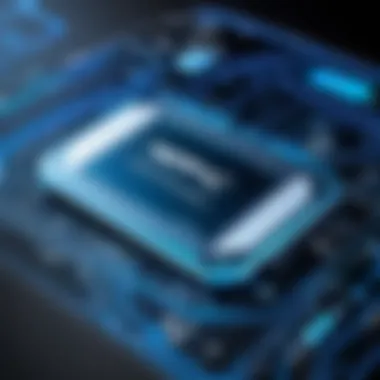Exploring the World of NFC Transponders


Intro
Near Field Communication (NFC) transponders represent a significant technological advancement in the realm of communication. Functioning as a bridge between devices in close proximity, these transponders facilitate data transfer without physical contact. As NFC technology continues to expand its footprint across various sectors, it becomes increasingly pertinent to understand how these devices operate, their myriad applications, and the security concerns surrounding them.
The landscape of NFC technology is not only technical but also heavily influenced by practical implementations in daily life, making it a relevant topic for IT professionals, cybersecurity experts, and students alike. In this exploration, we will delve deeply into the intricate aspects of NFC transponders, their functionality, and the implications associated with their use.
The journey through this guide will cover diverse areas such as basic concepts in communication technology, detailed examinations of both storage and security elements related to NFC, industry trends, and case studies illustrating real-world applications. Additionally, we will evaluate various tools and solutions that enhance the usability and security of NFC operations, equipping readers with actionable knowledge.
Ultimately, this article aims to present a comprehensive view of NFC transponders, helping the audience grasp the fundamentals while preparing them for future advancements and challenges in this vital field.
Preamble to NFC Technology
NFC technology has become an integral part of modern communication and interaction processes. It allows two devices to communicate when they are in proximity, offering a range of functionalities that enhance user experiences across various domains. The significance of NFC technology in this article lies in its impact and applications, particularly in simplifying mobile payments, data transfer, and access control systems.
The benefits of Near Field Communication are manifold. Firstly, it provides a seamless method for exchanging information without the need for manual connection setups. This ease of use makes it especially attractive for consumers and businesses alike. Additionally, NFC technology promotes security through short-range communication; the closer devices are together, the more secure the data exchange becomes. This characteristic is crucial for applications requiring sensitive transactions, such as banking and personal identification.
Factors to consider when understanding NFC technology include how it differs from other wireless communication methods, its limitations, and its capacity to work effectively in various environments. Users, IT professionals, and developers should be aware of potential challenges and how to overcome them in order to integrate NFC solutions effectively into their workflows. Overall, this section aims to set a solid foundation for readers to grasp the significance of NFC technology as used in transponders.
Definition of NFC
Near Field Communication, or NFC, refers to a set of communication protocols that enable short-range wireless communication between compatible devices. Typically, this technology operates over distances of about ten centimeters or less. NFC is characterized by its ability to establish connections quickly and easily without needing complex setups. This makes it a prominent choice for an array of applications.
Examples of NFC usage include mobile payments through services like Google Pay or Apple Pay, ticketing systems in public transport, and data sharing between smartphones.
Brief History of NFC Development
NFC technology has its roots in the RFID (Radio Frequency Identification) communication field. The initial concepts of NFC were explored in the early 2000s, with standards being developed to enhance interoperability. In 2002, the NFC Forum was established by a group of companies, including Sony and NXP Semiconductors, to promote the adoption and standardization of NFC technology.
Since its inception, NFC has evolved significantly. Early applications focused on contactless payment systems. However, as technology advanced, the scope of NFC expanded to include data exchange, device pairing, and other consumer interaction methods. Today, NFC is ubiquitous in smartphones and various consumer goods, showcasing its versatility.
How NFC Works
The working principle of NFC involves electromagnetic fields to enable communication between devices. When two NFC-enabled devices come within range, they create an electromagnetic field that facilitates data transfer between them.
NFC communication can occur in several modes:
- Peer-to-Peer Mode: This allows two NFC devices to exchange data in both directions. For example, two smartphones can share contact details or photos.
- Reader/Writer Mode: One device acts as a reader, while the other has NFC tags that can be read. This is typical in applications like accessing information from smart posters or NFC-enabled business cards.
- Card Emulation Mode: In this scenario, a device mimics a contactless smart card, allowing users to make payments or access secure facilities.
Understanding these functionalities helps users leverage NFC technology to its fullest potential, especially in business and consumer environments.
What is an NFC Transponder?
An NFC transponder is a small device embedded with a chip and antenna that enables communication within the NFC standard. It can store information and transmit it to NFC-enabled devices, such as smartphones, when they are in proximity, typically within a few centimeters. This functionality allows for the transfer of data quickly and securely, making it integral to many applications like contactless payments and automated access systems. The efficiency of NFC transponders lies in their ability to facilitate two-way communication between devices, allowing them to both send and receive data.
Components of NFC Transponders
The main components of NFC transponders include a microchip and an antenna. The microchip is responsible for processing and storing data, while the antenna enables the device to communicate wirelessly with other NFC-enabled products. The design and efficiency of these components directly influence the performance of the NFC transponder.
- Microchip: This component manages data storage and transfer. It can differ in capacity depending on the application, supporting simple tasks like URL redirection or complex functions like secure transaction verifications.
- Antenna: The antenna's design affects the operational range and efficiency of data transfer. A well-designed antenna can improve communication reliability, crucial for effective operation in varied environments.
Types of NFC Transponders
NFC transponders are generally categorized into three types: passive transponders, active transponders, and read-only/read-write transponders. Each type holds different characteristics and serves distinct purposes.


Passive Transponders
Passive transponders do not require their own power source. Instead, they obtain energy from the electromagnetic field generated by an NFC reader. As a result, they are often smaller and less expensive, making them a popular choice for various applications. The key characteristic of passive transponders is their ability to remain dormant until activated by a nearby device.
Advantages:
- Cost-effective: Their lack of a power source reduces overall costs.
- Durability: Typically, they have a longer lifespan due to fewer electronic components.
Disadvantages:
- Limited range: Passive transponders can only operate when very close to the reader.
Active Transponders
Active transponders, on the other hand, have their own power source, which allows for a broader range of functionality. They can send and receive data, making them useful for more complex tasks. The integration of a power source enables active transponders to send signals autonomously rather than waiting for an external trigger.
Advantages:
- Extended range: These transponders can communicate over greater distances compared to passive ones.
- Enhanced capabilities: They can support complex operations, such as data logging or responsive interactions.
Disadvantages:
- Higher cost: The added components may increase the overall price.
Read-Only and Read-Write Transponders
Read-only and read-write transponders refer to the accessibility of the information stored within them. Read-only transponders contain fixed data that cannot be altered, while read-write transponders permit users to modify the stored data.
Advantages of Read-Only:
- Security: Fixed data reduces the risk of unauthorized changes.
- Simplicity: Easy to implement in applications where data doesn’t need updating.
Advantages of Read-Write:
- Flexibility: Enables updates for various applications, such as loyalty programs or ticketing.
- Interactivity: Allows for dynamic responses based on real-time information.
Each type of NFC transponder has its unique features and practical applications. An in-depth understanding of these transponders is crucial to appreciating how they enhance NFC technology and its myriad uses.
Applications of NFC Transponders
NFC transponders have a wide range of applications, reflecting their unique capabilities and potential to enhance various processes. These devices enable quick data exchanges and interactions that contribute to convenience and efficiency in daily tasks. Understanding the applications of NFC transponders is essential for professionals and organizations looking to leverage this technology effectively. Here, we explore several prominent use cases that illustrate the significance of NFC in today’s digital landscape.
Smartphones and Mobile Payments
One of the most widespread applications of NFC transponders is within smartphones, particularly in the context of mobile payments. Applications like Google Pay, Apple Pay, and Samsung Pay utilize NFC technology to allow users to make transactions with a simple tap of their devices at compatible terminals. This method streamlines the payment process, eliminating the need for cash or cards.
The convenience of mobile payments also raises security considerations. NFC transactions use encryption and various authentication measures to safeguard users’ financial information. These elements make mobile payments not only efficient but also secure, attracting more users to abandon traditional payment methods.
Access Control Systems
NFC transponders are integral to modern access control systems. These systems utilize NFC-enabled cards or devices for secure entry into restricted areas. Users simply tap their NFC-enabled device against the reader to gain access, reducing the hassle often associated with traditional key-based entry.
Some advantages of using NFC in access control include:
- Improved Security: Enhanced encryption methods protect against unauthorized access.
- Ease of Use: Quick tap actions streamline the entry process for users.
- Flexibility: Access rights can be easily updated without changing physical locks.


This application is evident in sectors such as corporate offices, universities, and public facilities, where secure access is crucial.
Smart Posters and Marketing
NFC technology is also increasingly being used in marketing and advertising through smart posters. These posters contain NFC tags that link to online content or promotions. When a consumer taps their NFC-capable device against the tag, they instantly access additional information, promotional offers, or product details.
For marketers, this creates opportunities for engaging customers and tracking interactions. Data gathered from NFC interactions can inform marketing strategies and improve consumer engagement. This feedback loop is vital in maximizing advertising effectiveness.
Healthcare Applications
In the healthcare sector, NFC transponders facilitate various applications that enhance patient care and operational efficiency. For instance, NFC-enabled wristbands can be used to identify patients accurately, ensuring that medical staff have instant access to their medical history and treatment plans.
Moreover, NFC can streamline processes like medication management. Healthcare providers can use NFC technology to monitor medication administration, reducing the risk of errors.
Some specific benefits of NFC in healthcare include:
- Fast Access to Data: Medical records can be retrieved quickly using NFC devices.
- Improved Tracking: NFC helps monitor equipment and inventory in hospitals.
- Patient Identification: Reduces chances of misidentification or fraud.
"NFC transponders are proving to be a pivotal technology in enhancing operational workflows and improving patient safety in healthcare settings."
In summary, NFC transponders play a significant role across various domains such as mobile payments, access control, marketing, and healthcare. Their ability to streamline processes while providing security makes them invaluable in our increasingly digital world. Understanding these applications enables professionals and organizations to effectively adopt and integrate NFC technologies into their operations.
Integration with Other Technologies
The segment on integration with other technologies is critical for a comprehensive understanding of NFC transponders. This aspect highlights the flexibility and adaptability of Near Field Communication technology in various environments. By examining how NFC interacts and integrates with other systems, one can gain insight into its capabilities, limitations, and vast potential.
Integrating NFC with other technologies allows it to enhance user experiences and provide greater functionality. It expands the utility of NFC beyond simple payment systems into broader applications like access control, smart devices, and more. Given the rise of interconnected devices in various sectors, understanding these integrations sheds light on potential advancements and new use cases.
Knowing how NFC can work alongside other technologies, such as RFID, IoT, and Bluetooth, is essential for IT professionals and cybersecurity experts. They must consider factors like range, speed, and security mechanics of each technology when forming systems that require multitier communication.
NFC and RFID: Key Differences
NFC and RFID are often mentioned in the same breath due to their similarities, yet they are distinct technologies.
- Range: NFC has a very short range, typically within 4 inches, while RFID can operate over several feet, depending on the type.
- Communication: NFC allows for two-way communication between devices, while RFID generally functions in a one-way model.
- Usage: NFC is commonly used in payments and ticketing systems, whereas RFID is prevalent in inventory management and tracking.
Understanding these differences enables professionals to choose the right technology for specific applications. This recognition is vital for crafting effective systems and for security assessments, particularly since RFID's broader range can be a vulnerability in certain contexts.
NFC in the Internet of Things (IoT)
The integration of NFC within the Internet of Things significantly enhances the ecosystem of connected devices. NFC provides a straightforward method for devices to communicate with each other over short distances. This capability is beneficial in automating tasks, improving efficiency, and enhancing security.
Examples include:
- Smart Home Devices: NFC can simplify connections between smart home products, making it easier for users to control devices with their smartphones.
- Wearables: NFC transponders in wearables can facilitate seamless transactions and connectivity, giving users more control in convenient formats.
As IoT continues to expand, the role of NFC must not be undervalued. Its contribution to interoperability can streamline connections and provide security measures vital in smart environments.
Compatibility with Other Wireless Technologies
NFC's compatibility with other wireless technologies is an imperative consideration. It works seamlessly alongside systems like Bluetooth and Wi-Fi, allowing devices to share data efficiently. When paired with Bluetooth, for instance, NFC can facilitate the initial connection setup before the device transitions to Bluetooth for data transfer.
Using NFC in conjunction with Wi-Fi offers significant advantages in applications such as:


- Mobile payments processing
- Device pairing configurations
- Downloading content or programs instantly
Moreover, the synergy with cloud technologies further fosters innovation in various sectors. This combination encourages improved security measures, better data management, and enhanced user experiences, ultimately leading to richer applications in the digital ecosystem.
Security and Privacy Concerns
In the realm of NFC transponders, security and privacy concerns are paramount. As NFC technology facilitates seamless communication between devices, it undeniably raises questions about data protection and unauthorized access. Understanding these vulnerabilities is crucial not just for manufacturers but also for end users who rely on NFC applications in various contexts.
Vulnerabilities of NFC Technology
NFC technology, despite its convenience, has inherent vulnerabilities that can be exploited. Key issues include:
- Eavesdropping: Attackers can intercept NFC signals during transmission. Since NFC operates over short distances, anyone within range can theoretically tap into this communication unless adequately protected.
- Data Manipulation: Malicious entities can alter the information being transmitted between devices. If an attacker gains access to an NFC session, they can inject false data or commands.
- Relay Attacks: In a relay attack, an attacker captures and relays NFC signals from one device to another, tricking the devices into thinking they are in close proximity. This type of attack can bypass many security measures that rely on proximity.
These vulnerabilities underline the importance of implementing robust security protocols to mitigate risks.
Preventive Measures and Best Practices
To address security concerns associated with NFC technology, several preventive measures and best practices can be employed. These strategies help to create a safer environment for users and enhance the overall security of NFC interactions:
- Encryption: Utilize robust encryption methods for data transmitted over NFC to ensure that even if data is intercepted, it remains unreadable to unauthorized parties.
- Limit NFC Usage: Users should disable NFC on devices when not in use to minimize the risk of unauthorized access.
- Awareness and Training: Educating users about the risks involved with NFC technology can significantly reduce possible data breaches. By being aware of potential vulnerabilities, users can take proactive measures.
- Regular Software Updates: Keeping devices updated with the latest software can protect against known vulnerabilities. Manufacturers often release security patches to fix identified weaknesses.
- Secure Pairing Protocols: Implementing protocols such as Secure Simple Pairing (SSP) can enhance the security of NFC interactions, making it harder for attackers to exploit vulnerabilities.
"Security is not a product, but a process" - This underscores the ongoing need for vigilance and updates in the security landscape of NFC technology.
In summary, recognizing the vulnerabilities of NFC technology is the first step towards safeguarding its use. By adhering to best practices and ensuring proper security measures are in place, both individuals and organizations can mitigate the potential risks associated with NFC transponders.
Future Trends in NFC Technology
As we look ahead, the evolution of Near Field Communication (NFC) technology continues to unfold with several significant trends. It is imperative to recognize how these developments will shape the landscape of NFC transponders and their applications. The relevance of future trends in NFC technology cannot be understated, especially for IT professionals, cybersecurity experts, and students, who will benefit from understanding the potential impacts on systems and security.
Emerging Use Cases
The adaptability of NFC technology leads to innovative use cases that go beyond traditional applications. For instance, the integration of NFC in smart city initiatives enhances everyday experiences. Smart parking solutions use NFC-enabled devices, allowing users to pay for parking seamlessly via mobile applications. Healthcare is another area benefiting from NFC, as patient data can be accessed quickly and securely through NFC wristbands. This increases efficiency while ensuring sensitive information remains protected. The growing trend of using NFC in retail also deserves attention. Consumers can engage with products directly, receiving personalized promotions through smart tags. As more retailers adopt this technology, customer engagement strategies will evolve.
Advancements in NFC Hardware
Hardware development is crucial for NFC transponders. Manufacturers are focusing on miniaturizing chips and enhancing energy efficiency. These advancements result in smaller devices operating at lower power levels while maintaining performance. Additionally, improving the read range is a key area of research. Emerging technologies may allow NFC devices to communicate over greater distances without compromising security. The introduction of multi-protocol NFC chips is another significant trend. These chips facilitate compatibility with multiple systems, such as Bluetooth and Wi-Fi, increasing the functionality of mobile devices and smart gadgets.
Integration with Blockchain Technology
The intersection of NFC and blockchain technology opens a new frontier for security and data integrity. By integrating blockchain, NFC transponders can create immutable records for transactions. This is particularly beneficial in industries such as supply chain management, where tracking the provenance of goods is essential. Furthermore, NFC devices can enhance security protocols in financial transactions. Combining both technologies ensures that sensitive data is not only encrypted but also offers transparency in validation processes. Businesses will need to consider the implications of this integration carefully, particularly regarding compliance and technology infrastructure.
"The fusion of NFC and blockchain technology presents new opportunities for enhanced security while maintaining user convenience."
The continuous advancements in NFC technology signal that professionals and students alike must stay informed about these future trends. Being proactive in understanding these changes will foster innovation and improve overall security.
End and Key Takeaways
In summary, the discussion surrounding NFC transponders is vital for IT professionals, cybersecurity experts, and students alike. This technology is not just a tool for convenience; it plays a critical role in security and innovation across various sectors. Understanding the nuances of NFC transponders is essential for developing secure systems and applications that leverage this technology effectively.
Summary of Key Points
- Definition and Importance: NFC transponders facilitate contactless communication and transactions. Their role in enabling mobile payments and access control systems demonstrates their growing significance in modern technology.
- Types of NFC Transponders: There are various types, such as passive and active transponders. Each type has unique characteristics that cater to specific applications, making it essential to choose the right one based on the use case.
- Applications: NFC technology is embedded in everyday devices like smartphones. It also finds use in healthcare, marketing, and security systems, showcasing its versatility.
- Security Concerns: While NFC offers benefits, there are vulnerabilities to consider. Understanding these risks is crucial for implementing proper protective measures.
- Future Trends: As technology evolves, so does NFC. Emerging trends like integration with blockchain and the Internet of Things will likely shape its future applications.
The Importance of Staying Informed
Keeping up with developments in NFC technology is critical. New threats to security and emerging applications can drastically change its landscape. Professionals must remain aware of both risks and innovations to leverage NFC effectively. Continuous education and vigilance are necessary to ensure the application of best practices when utilizing NFC transponders. Moreover, this knowledge allows readers to engage with ongoing conversations about the future of technology in their respective fields.
"In the fast-evolving landscape of technology, staying informed about NFC transponders not only enhances understanding but also prepares one for future developments that impact security and innovation."
By synthesizing the information presented throughout this article, it becomes clear that NFC transponders are not merely a technological curiosity but a fundamental aspect of modern communications and transactions. The importance of understanding their functionality and implications cannot be overstated.



